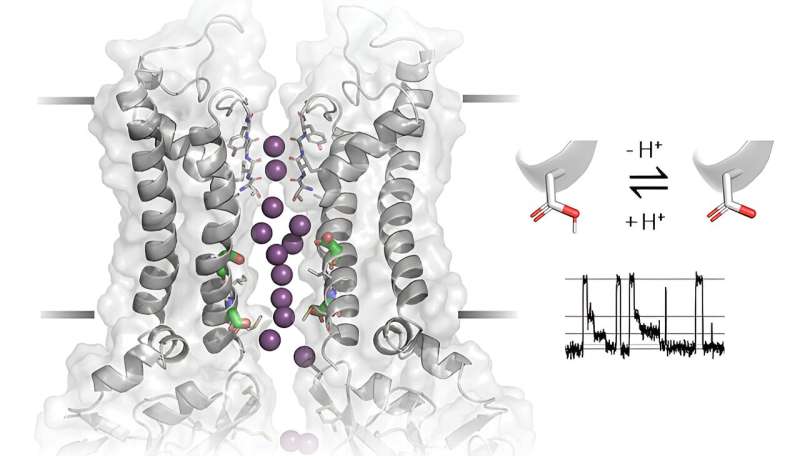This article has been reviewed according to Science X's editorial process and policies. Editors have highlighted the following attributes while ensuring the content's credibility:
fact-checked
peer-reviewed publication
trusted source
proofread
New study sheds light on the gating mechanism of ion channels

Ion channels play a crucial role in many cellular processes, including neuronal communication, muscle contraction or cell proliferation.
Most multi subunit ion channels exist in two functional states, either closed or open. During gating, one should expect that all subunits undergo conformational changes. The absence of intermediate conduction levels is surprising and asks for an explanation.
A team of researchers from the University of Vienna and the Washington University in St. Louis created a smart model system to answer this important question. The study is published in Nature Communications.
Ion channels are membrane proteins that regulate the electrical activity of cells. In this study the scientific team investigated the inwardly rectifying potassium channel Kir2. This channel is crucial for maintaining a negative membrane potential in many cells. These channels are promising drug targets for treatment of cardiovascular diseases. To foster drug development, a detailed understanding of the gating mechanism is important.
Intelligent model system & innovative methods
"We designed a model system that allowed us to visualize the gating of individual subunits and track conductance changes," explains Grigory Maksaev from the Washington University in St. Louis.
As a model system, the inwardly rectifying potassium channel Kir2 was used. This channel is crucial for maintaining a negative membrane potential in many cells. "We introduced an acidic residue near the channel gate. This led to novel states, so-called sub-conductance states," explains Eva Plessl from the Department of Pharmaceutical Sciences, University of Vienna.
The lifetimes of these sub-states were long enough to resolve them experimentally. Each of the observed sub-states represents a distinct subunit conformation. Interestingly, the sub-state occupancy is titratable by pH. "This suggests that protonation or deprotonation of individual acidic residues causes this phenomenon," said Sun-Joo Lee from the Washington University in St. Louis.
"Molecular dynamics simulations with different protonation states of the acidic residue support this finding," explains Anna Weinzinger from the Department of Pharmaceutical Sciences, University of Vienna.
The study reveals that each subunit gating transition leads to conductance level changes. This suggests that for a fully open channel, all subunits must move together. "By designing a smart model system, we have answered a long-standing question about ion channel gating," said Colin Nichols from the Washington University in St. Louis.
More information: Grigory Maksaev et al, Subunit gating resulting from individual protonation events in Kir2 channels, Nature Communications (2023). DOI: 10.1038/s41467-023-40058-7
Journal information: Nature Communications
Provided by University of Vienna





















